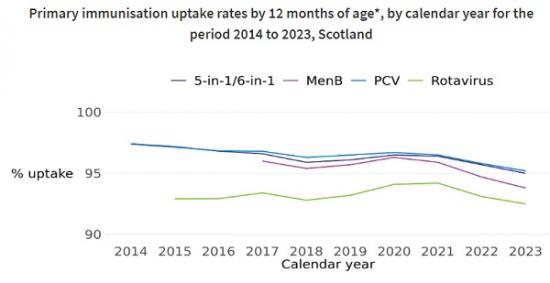Childhood Immunisation Statistics Scotland - Quarter And Year Ending 31 December 2023
29th March 2024

This release by Public Health Scotland (PHS) provides an annual and quarterly update of immunisation uptake rates for children in Scotland. Immunisation programmes for children aim to protect the individual child from many serious infectious diseases and prevent the spread of disease in the wider population. Information is shown for NHS Boards and local authorities, at 12 months, 24 months, 5 years and 6 years of age.
Main points
Annual uptake rates have shown gradual declines in Scotland over the past 10 years across all routine immunisations. However, throughout this period uptake has remained high. In 2023, uptake by the time children were 12 months old was: Pneumococcal Conjugate Vaccine (PCV) (95.2%), 6-in-1 (95.0%), MenB (93.8%), Rotavirus (92.5%).
*Children turning 12 months of age in the relevant year e.g. for 2023 this would be children born during January-December 2022
In 2023, most children received their booster vaccines by 24 months of age: Hib/MenC (93.0%), PCV (92.9%) and MenB (92.3%).
The first dose of MMR vaccine is offered between 12 and 13 months old and the second dose from 3 years 4 months old. In calendar year 2023;
93.0% of children had the first dose of MMR vaccine by 24 months of age. This rose to 95.2% for children who had reached age 5.
Uptake of the second dose of MMR vaccine by 5 years was 89.1%, rising to 90.4% by age 6 years.
Uptake of the 4-in-1 vaccine was 89.6% for children who had reached 5 years old, rising to 91.1% by age 6 years.
Children from the more deprived areas were less likely to take up the vaccines than children in the less deprived areas, or receive their vaccines later.
Background
As a public health measure, immunisations are very effective in reducing the burden of disease. The European Region of the World Health Organization (WHO) recommends that on a national basis at least 95% of children are immunised against diseases preventable by immunisation and targeted for elimination or control. These include diphtheria, tetanus, pertussis, polio, Haemophilus influenzae type b (Hib), measles, mumps and rubella.
Rotavirus vaccine should be given within strict age limits, with the first dose before 15 weeks and second dose before 24 weeks of age. These age limits mean that if a child is not immunised with the first dose early enough, due to missed appointments for example, then it may not be possible for them to complete the full 2 dose course before 24 weeks. This explains why uptake of the completed 2 dose course of rotavirus vaccine is slightly lower than completed courses of the other vaccines offered in the first year of life.
